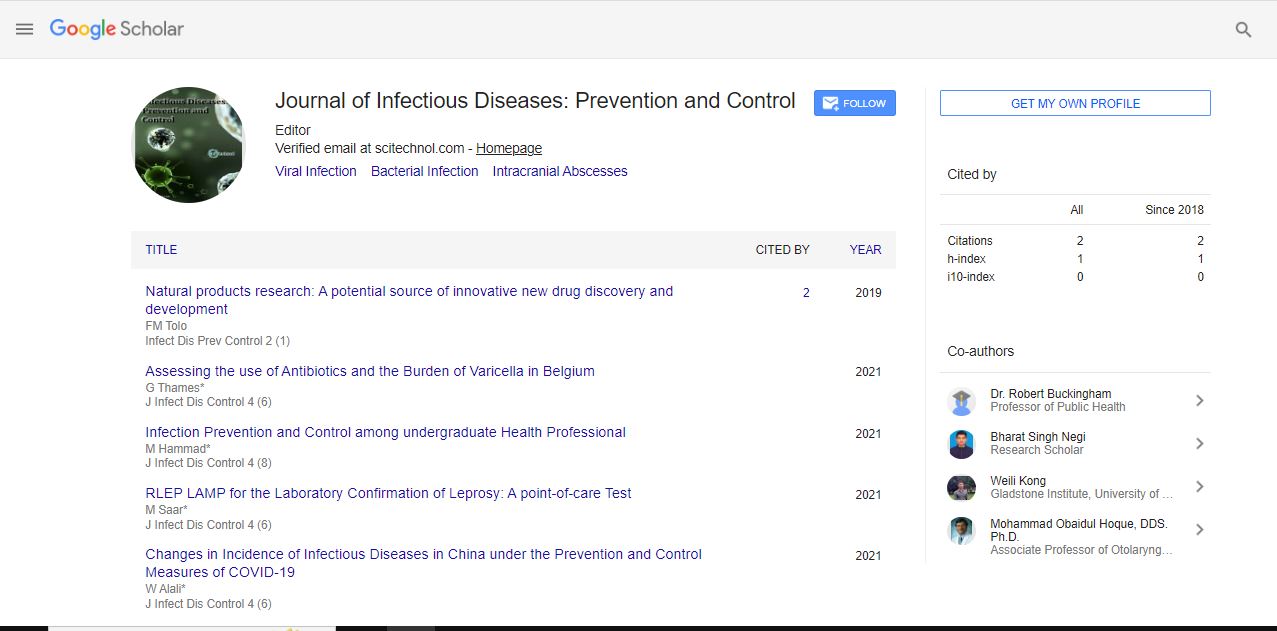Commentary, Vol: 6 Issue: 3
Prevention and Vaccination Strategies for Hepatitis A and B
Mirna Benjami*
1Department of Immunology and Inflammation, Imperial College London, London, United Kingdom
*Corresponding Author: Mirna Benjamin,
Department of Immunology and
Inflammation, Imperial College London, London, United Kingdom
E-mail: Benjamin. Mirn@ki.se
Received date: 30 August, 2023, Manuscript No. IDPC-23-116458;
Editor assigned date: 01 September, 2023, PreQC No. IDPC-23-116458 (PQ);
Reviewed date: 15 September, 2023, QC No. IDPC-23-116458;
Revised date: 22 September, 2023, Manuscript No. IDPC-23-116458 (R);
Published date: 29 September, 2023, DOI: 10.36648/idpc.6.3.144
Citation: Benjami M (2023) Prevention and Vaccination Strategies for Hepatitis A and B. Infect Dis Prev Control 6:3.
Abstract
Description
Hepatitis A and B are two infectious diseases caused by different strains of the hepatitis virus. These viruses can have severe consequences on the liver, leading to acute and chronic liver diseases, and even death in some cases. Fortunately, both hepatitis A and B can be prevented through effective vaccination strategies. In this essay, we will explore the importance of prevention and vaccination in the context of hepatitis A and B, their modes of transmission, the characteristics of the vaccines, and the impact of vaccination on public health. Hepatitis A and B are both viral infections that target the liver, but they differ in several key ways.
Hepatitis A is primarily transmitted through the ingestion of contaminated food and water or by close personal contact with an infected individual. It typically results in an acute infection and, in most cases, does not lead to chronic liver disease. Symptoms can range from mild to severe and may include jaundice, fatigue, and abdominal pain. However, the disease is generally self-limiting, and most individuals recover without long-term complications. Hepatitis B, on the other hand, is primarily transmitted through exposure to infected blood and other bodily fluids, such as during unprotected sexual intercourse, sharing of needles, or from mother to child during childbirth. Unlike hepatitis A, hepatitis B can lead to chronic infection, cirrhosis, and even liver cancer. Chronic hepatitis B is a significant global health concern, with over 250 million people estimated to be living with chronic hepatitis B infection. Hepatitis A can be effectively prevented through vaccination. The hepatitis A vaccine is a highly effective tool in controlling the spread of the virus. The vaccine contains inactivated hepatitis A virus, which stimulates the immune system to produce protective antibodies. In many countries, routine vaccination programs have been established to immunize individuals, particularly children, against hepatitis A.
Routine vaccination is often complemented by targeted vaccination strategies during outbreaks and for individuals at high risk of exposure. These include travelers to regions with high hepatitis A prevalence and healthcare workers who may come into contact with infected individuals. Vaccination has significantly reduced the incidence of hepatitis A in countries with widespread immunization programs.
Hepatitis B vaccination is one of the most effective ways to prevent the transmission of the virus. The hepatitis B vaccine is made from a non-infectious portion of the hepatitis B virus, which triggers the body's immune response to produce antibodies. This response provides protection against future infection. Routine vaccination for hepatitis B is typically initiated during infancy, with a series of shots given in the first year of life. The vaccine is also recommended for healthcare workers, individuals with high-risk behaviors (such as injection drug users and those with multiple sexual partners), and anyone seeking protection from hepatitis B. Additionally, hepatitis B vaccination is essential for preventing mother-to-child transmission of the virus.
Impact of vaccination on public health
The widespread implementation of hepatitis A and B vaccination programs has had a profound impact on public health worldwide. Here are some key ways in which vaccination has made a difference:
Reduced disease incidence: Hepatitis A and B vaccination programs have significantly reduced the incidence of these diseases, leading to fewer cases and milder infections in those who do contract the virus.
Prevention of chronic infections: Hepatitis B vaccination, in particular, has been successful in preventing chronic hepatitis B infections, reducing the risk of cirrhosis and liver cancer.
Herd immunity: Widespread vaccination not only protects vaccinated individuals but also contributes to herd immunity, reducing the overall transmission of the virus within communities.Economic benefits: Vaccination programs save healthcare costs by preventing expensive treatments for chronic liver diseases and reducing the economic burden of lost productivity due to illness.
Economic benefits: Vaccination programs save healthcare costs by preventing expensive treatments for chronic liver diseases and reducing the economic burden of lost productivity due to illness.
Global health impact: International vaccination efforts have helped control the spread of hepatitis A and B in many countries, contributing to the global goal of eradicating these diseases.
While hepatitis A and B vaccination has been successful in preventing these diseases, challenges remain. Hepatitis A outbreaks can still occur, particularly in areas with poor sanitation and hygiene. For hepatitis B, access to vaccination remains limited in some regions, and there is a need for continued efforts to expand coverage and reduce disparities.
Moreover, there are other strains of hepatitis viruses, such as hepatitis C and E, for which vaccines are still under development. The success of hepatitis A and B vaccination programs serves as a model for the development and implementation of vaccines for these and other hepatitis strains. Prevention and vaccination strategies for hepatitis A and B have had a significant impact on public health by reducing the incidence of these diseases, preventing chronic infections, and improving the overall well-being of populations. Routine immunization, targeted vaccination campaigns, and international efforts have played vital roles in controlling the spread of these viruses. While challenges remain, the success of these vaccination programs demonstrates the importance of vaccines in preventing infectious diseases and underscores the need for continued investment in vaccine development and distribution to protect the health of individuals and communities worldwide.
 Spanish
Spanish  Chinese
Chinese  Russian
Russian  German
German  French
French  Japanese
Japanese  Portuguese
Portuguese  Hindi
Hindi 